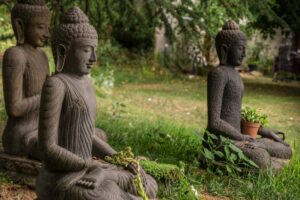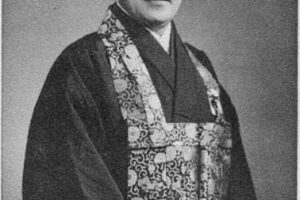
To celebrate its 30th anniversary, Hubble took this picture of a star-forming region nicknamed the Cosmic Reef. Photograph: STScl/Nasa ESA
Fan blades nod rapport
Blown hard by the passing wind
this cold spring morning
At the end of Genjokoan, Master Dogen’s tract excerpted from Bendowa, the first fascicle of his masterwork Shobogenzo chanted in the Soto Zen liturgy, comes the passage (punctuation mine):
Zen master Baoche of Mt. Mayu was fanning himself.
A monk approached and said, “Master the nature of wind is permanent,
and there is no place it does not reach. Why, then, do you fan yourself?”
“Although you understand that the nature of the wind is permanent”
Baoche replied, “you do not understand the meaning of its reaching everywhere.”
“What is the meaning of its reaching everywhere?” asked the monk again.
The master just kept fanning himself.
The monk bowed deeply.
The actualization of the buddha-dharma, the vital path of its correct transmission, is like this.
If you say that you do not need to fan yourself because the nature of wind is permanent and you can have wind without fanning you will understand neither permanence nor the nature of wind.
The nature of wind is permanent! Because of that the wind of the Buddha’s house brings forth the gold of the earth and makes fragrant the cream of the long river.
Although the electric, oscillating fan in my bedroom is an insentient being, a mere mechanical device, it is not unresponsive to the causes and conditions surrounding it. The cold wind blowing in through the open window moves its blades, as well as the 40-foot tall stand of black bamboo in the back yard, all unaware of any distinction between the two. The proximate wind moved down from the arctic riding the jetstream or up from the south on the wings of the gulfstream. Before that it was moving sand dunes in a desert and skimming snow from mountaintops, roiling the surface of an ocean. This wind permeates everywhere, penetrating to the bottom of the Mariana Trench, and to the tip-top of Mount Everest. Though ever-changing, it is permanent in nature.
Even where there is no atmosphere, in the vastness of outer space, there is this wind. Not only the solar wind and the flow of gravitational forces, but the very life-force of Zen. The long river is the local manifestation we call the Milky Way, long lost to us urbanites in the up-wash from city lights. During the pandemic shutdown, one of the more delightful side-effects was the dark and quiet night, taking me back to childhood on the farm.
Human beings are also of the nature of this universal wind, our bodies blowing away to the horizon, the impermanent defining the permanent. But we cannot have the wind of Buddha’s house without doing the fanning ourselves. We alone can do the work to mine and smelt the gold of the earth, and smell the fragrance of the galaxy. Like smelting gold, each time we have to begin anew.
The monk may seem impertinent to challenge the master’s fanning himself, but his remark reveals an intimate, trusting affinity. The most mature Zen master is in the same position as the most novice of all monks. We must all do the work of fanning ourselves. Nowadays we can rely on our ceiling fans, air conditioning and oil-fired furnaces to bring us a manufactured, thermostatic wind to enhance our southern or northern comfort. But no device, however sophisticated, can do the fundamental fanning for us.
No fanning, no wind.
The wind is not separate from the other basic elements of earth, fire and water, space, and consciousness. We are all “in the wind,” whether we know it or not. This wind is like space, not only outside us, but inside as well. The body will dependably do the breathing, as long as it is able, and as long as we do not interfere. But it will also stop breathing one day, and there is not a damn thing we can do about it. In the interim, keep fanning.









